The Mausoleum of Genghis Khan (成吉思汗陵), located in the Bayin Changhuge Grassland within the territory of Yijin Horo Banner, Ordos city, is the symbol of the great historical man - Genghis Khan and the sacred place to worship the spirit of the great man. It’s the only tourist attraction in the world that takes Genghis Khan culture and Mongolian culture as the theme.
In the Genghis Khan Mausoleum Tourist Area, you may not only learn about the unique Mongolian history and nomadic culture, but can also feel the solemn and mysterious sacrifice ceremony of the Dalhutt people, participate in the dreamlike prairie bonfire party, watch the exciting and intense Nadaam Fair, enjoy special tourism projects in the grassland (watch horse racing, horse riding and archery, etc.), and enjoy the song and dance performances with strong Mongolian characteristics, like “Ordos Wedding ”, “The Palace” and “Zhuoma Banquet”, etc.
Genghis Khan, the khan of the Mongol Empire, formerly known as Tiemuzhen Borjigin (孛儿只斤·铁木真), was an outstanding politician and militarist in world history. In the spring of 1206, Genghis Khan founded the country and proclaimed himself emperor. After that, he launched many foreign conquest wars and the conquered territory westward can reach Central Asia and the Black Sea Coast of Eastern Europe. Believing in primitive shamanism, Mongolians believe that the soul of man is eternal, so they attach great importance to the sacrifice to the souls of ancestors. As the founder and ancestor of the Mongolian nation, Genghis Khan has won the worship of all Mongolians. People regard him as the "Emperor" and worship the national hero all the time. The Mausoleum of Genghis Khan, as the symbol of Genghis Khan's soul, has been a sacred place to worship Genghis Khan for more than 700 years.
 Genghis Khan (Tiemuzhen Borjigin)
Genghis Khan (Tiemuzhen Borjigin)
As a national monument, Genghis Khan Mausoleum records the vicissitudes of history and splendid culture of the Mongolian nation. There is also a very interesting story about the site of Genghis Khan's Mausoleum. Legend has it that Genghis Khan happened to pass through Ordos when he led his army to fight against the Western Xia Regime. When he saw the fertile soil, rich water, flourishing grass here and elegant sika deer, he was so happy that he accidentally dropped his riding whip on the ground. When one of his subordinates was about to pick up the riding whip, Genghis stopped him and murmured to himself, "Here is the place where the sika deer lives, the home where the birds raise their young, the site where the declining dynasties rejuvenate, and the land where the aged pleases themselves." Then he turned to his subordinates and said, "I can be buried here when I die." When the hearse carried Genghis Khan's coffin arrived in Ordos after his death, the wheels of the hearse suddenly sank into a swamp, and no amount of horses and oxen could pull it out. Then the general who escorted the hearse recalled what Genghis Khan had said, so he placed the yurt, his tunic and one of his stocking in the altar white room and formed the Babai Palace (八白宫), which is now the Mausoleum of Genghis Khan.
Till today, the real location of Genghis Khan's mausoleum remains a mystery. The Mausoleum of Genghis Khan, now built in Ordos, is a cenotaph and scenic area to commemorate Genghis Khan and carry forward its fine culture.
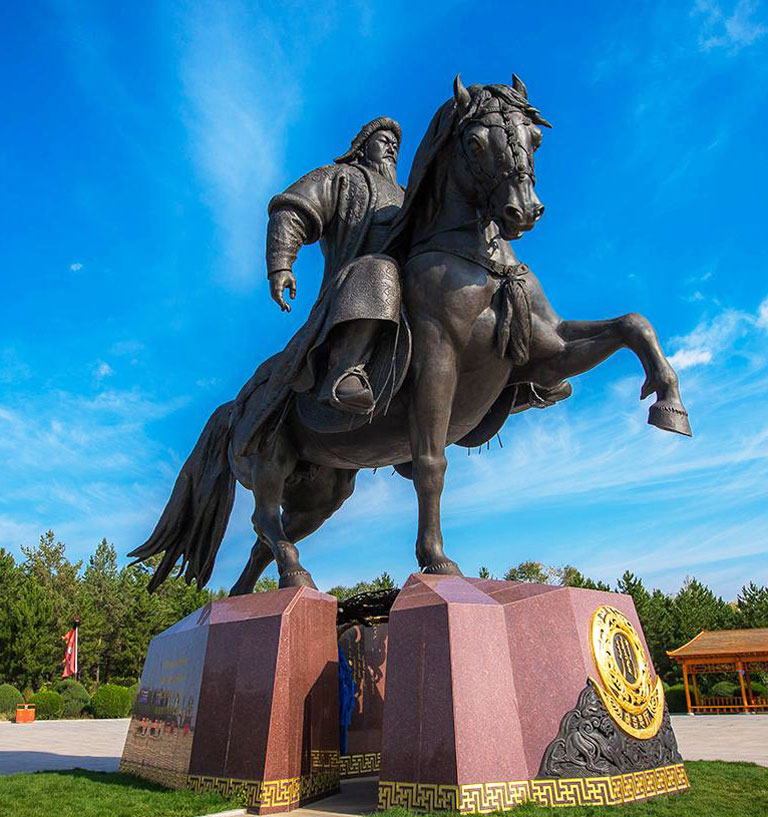 Statue of Genghis Khan in the Scenic Area
Statue of Genghis Khan in the Scenic Area
Genghis Khan Mausoleum Tourist Area covers an area of 10 square kilometers, and has a control area of 80 square kilometers. With the Mausoleum of Genghis Khan as the core, it has formed the layout of Sacrificial Culture Area, Historical Culture Area, Folk Culture Area, Grassland Sightseeing area and Leisure & Vacation Area.
Mausoleum Palace (成吉思汗陵宫) is a sacred place to worship Genghis Khan. The architecture retains the shape and characteristics of the eight White House of Genghis Khan, becoming the representative architecture of the Mongolian nation. The Mausoleum Palace of Genghis Khan consists of the main hall, the back hall, the east and west halls, and the east and west halls. The mausoleum palace has a construction area of 2000 square meters. The main hall is 24.18 meters high and the east and west halls are 18 meters high. The resplendent mausoleum palace, like an eagle flying wings, shows the grand momentum of the prairie emperor's mausoleum. The milky white walls, vermilion doors and windows, golden roofs and blue cloud pictures all have unique Mongolian characteristics. In the Mausoleum Palace, Eight White House (rooms) of Genghis Khan (八白宫) are enshrined, and there are huge murals there. Hanging in the middle of the eaves of the Mausoleum Palace is a plaque "Mausoleum of Genghis Khan" inscribed by former Vice President Ulan Fu.
The memorial gate presents the shape of "山(Shan)", Like a huge crest splitting from the top, towering statue of Genghis Khan prancing horse soaring out of the sky in the center, the eastern and western mountains were chiseled out... The shape of the condensed and dignified Qizhuang Shanhe Memorial Gate (气壮山河门) has a profound meaning that is the ground-breaking power and epoch-making grandeur, hence the name.
The Iron Horses and Golden Hordes (铁马金帐雕塑群) is the world’s first large scenic sculpture group which completely displays the army palace of Genghis Khan. The military life of Genghis Khans reappears in your eye. Conquering from north to south, spanning the territory from Asia to Europe with mighty and powerful forces, showing visitors the historical picture scroll of Genghis Khan's great achievements. When you step into the vast sculpture group, you can feel the real scene of Genghis Khan commanding millions of troops to fight bravely and unify Mongolia.
With the shape of the Mongolian word “Han (which means the emperor)”, the Mongolia History and Culture Museum (蒙古历史文化博物馆), also known as Genghis Khan Cultural Heritage Museum, is one of the typical architecture in Inner Mongolia. It is the first museum at home and abroad to collect, study and display the history and culture of the Mongolian ethnic group. The museum has collected a large number of Mongolian historical relics and exquisite and unique national artifacts since Genghis Khan, playing an important role in inheriting and carrying forward the long-established history and culture of the Mongolian nation.
The 206 years' historical picture scroll from the birth of Genghis Khan to the withdrawal of the Mongolian rulers from the Yuan capital and the Mobei steppe and the establishment of the Northern Yuan regime in the Yuan Dynasty, truly reflects the most glorious period of historical facts of the Mongolian nation and the historical process of realizing the reunification of the Chinese nation and accelerating the development of world civilization. The Long Scroll of Mongolian History (蒙古历史长卷), which is displayed in the museum, is the longest scroll in the world.
Alatan Gandel Obo (阿拉腾甘德尔敖包) was set up by the ancients to commemorate Genghis Khan's shedding of his riding whip. It brings together the most ancient shamanism sacrificial culture and sacrificial ceremonies of the Mongolian nation, and leads you into a mysterious altar where you can dialogue with the immortal heaven. On the altar stands the Chagaan Suld, which symbolizes the eternal residence of the spirit of Genghis Khan, reflecting the distinctive ethnic cultural characteristics of Ordos. Every year on the 21st day of the third lunar month, the worship ceremony of Chagansuluk festival is held here.
Mongol people worship heaven and believe that the heaven which dominates everything in the world is composed of ninety-nine levels. Genghis Khan once drew up the ropes of ten thousand herds of cattle and sprinkled the milk of ninety-nine female mares on the banks of the Cluren River to make sacrifice to heaven. Ninety-nine Steps (九十九级台阶) are a symbol of luck and happiness. Looking from a distance, it is like a surging river, implying that the "eternal river" of "Mongolia" created by Genghis Khan has a long history and will last forever.
Besides, the mausoleum area and on the grassland, a racecourse designed and built according to the international track standards and the traditional customs of the horse back ethnic group, staging the three arts of Nadaam (Mongolian horse race, Ordos wrestling and Hathar bowing) and other entertainment games with national characteristics. Paying a visit to Nadaam Equestrain Event Center (那达慕马术活动中心), you may feel like yourself entering a Mongolian competitive world, experiencing the Mongolian strength and wisdom of the contest of the happy mood.
Represented by the most typical cultural characteristics of the six Mongolian tribes, the Mongolian Families (蒙古人家) exhibition focuses on ancient and traditional production and life, etiquette and clothing, singing and dancing, religious and beliefs and other customs. It is like leading you into the deep grasslands and the Mongolian homes, and you can truly feel the unique culture and the thousand-year charm of the Mongolia ethnic group.
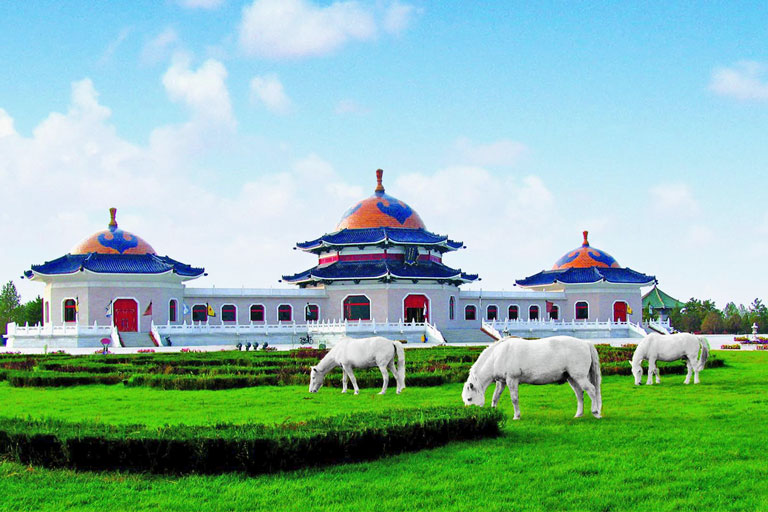 Genghis Khan Mausoleum Palace
Genghis Khan Mausoleum Palace
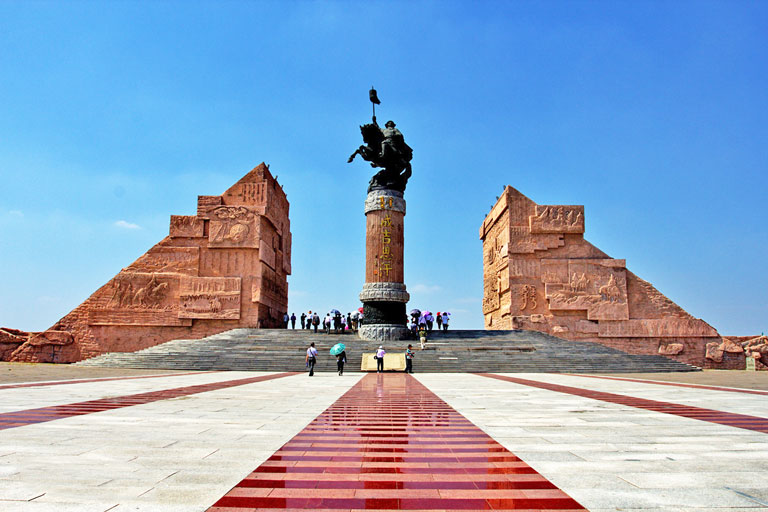 Qizhuang Shanhe Memorial Gate
Qizhuang Shanhe Memorial Gate
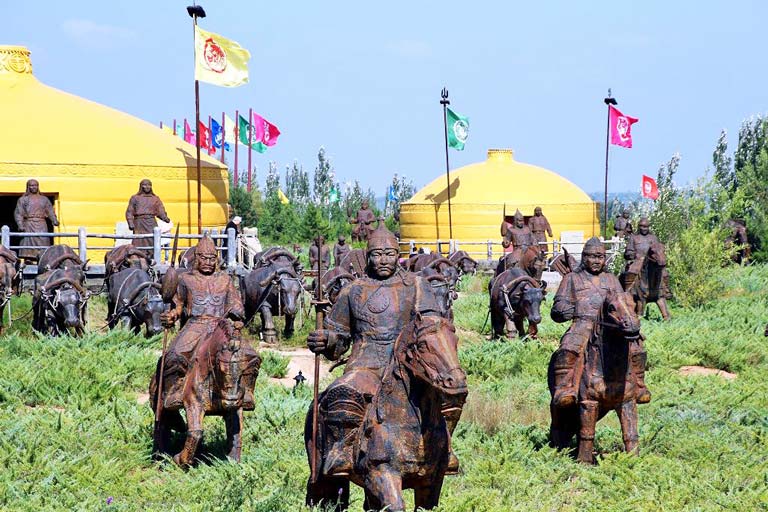 Iron Horses and Golden Hordes
Iron Horses and Golden Hordes
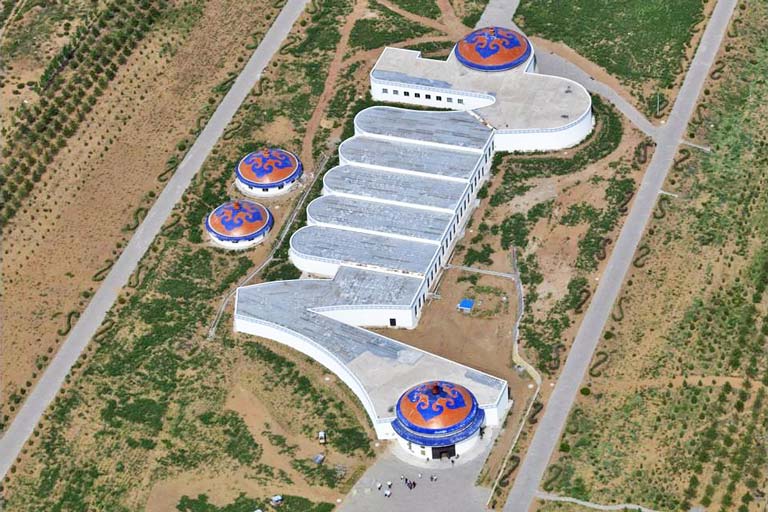 Mongolian History and Culture Museum
Mongolian History and Culture Museum
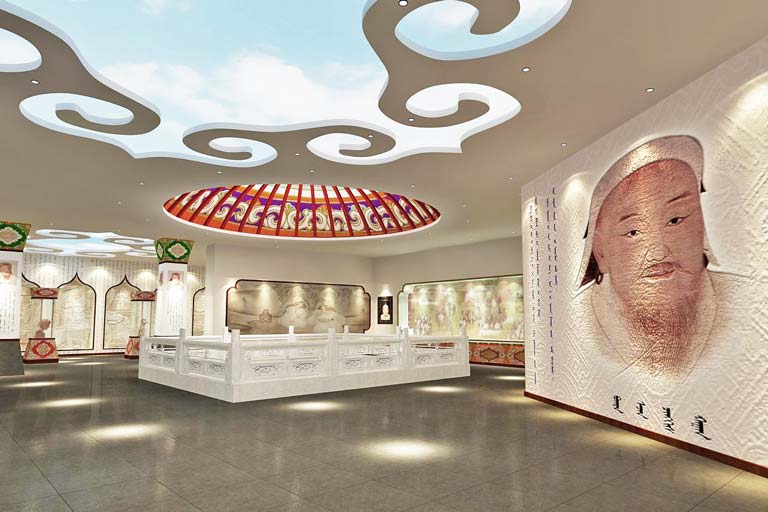 Inner of Genghis Khan Museum in Ordos
Inner of Genghis Khan Museum in Ordos
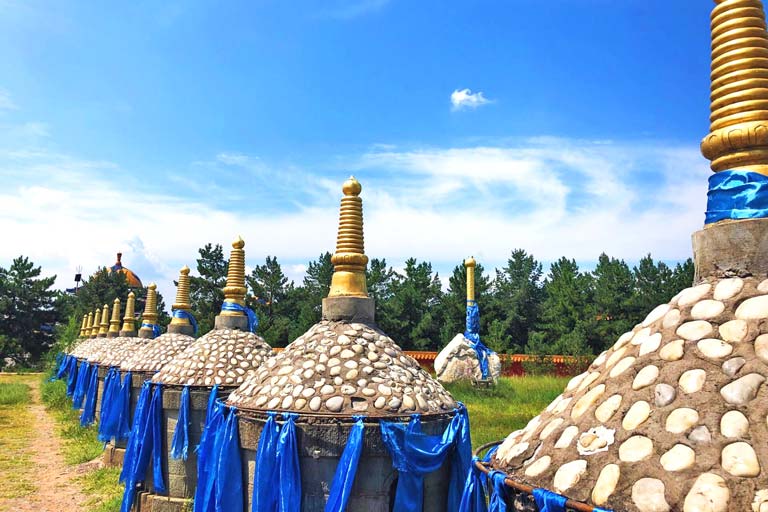 Alatan Gandel Obo
Alatan Gandel Obo
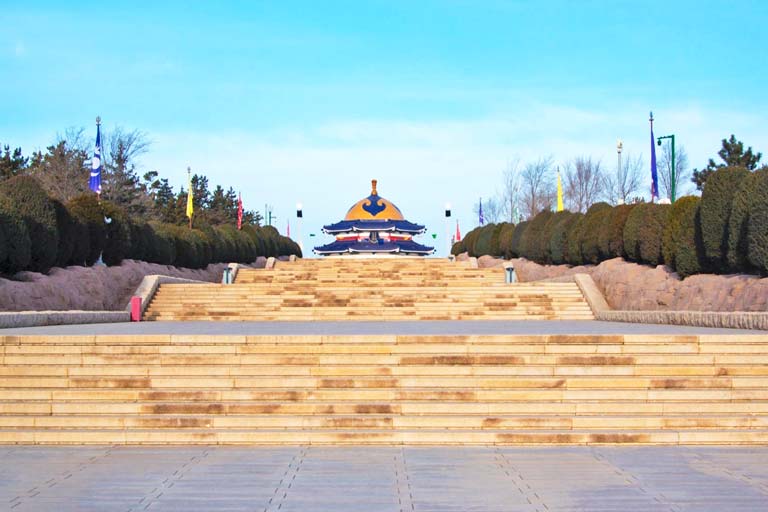 Ninety-nine Steps
Ninety-nine Steps
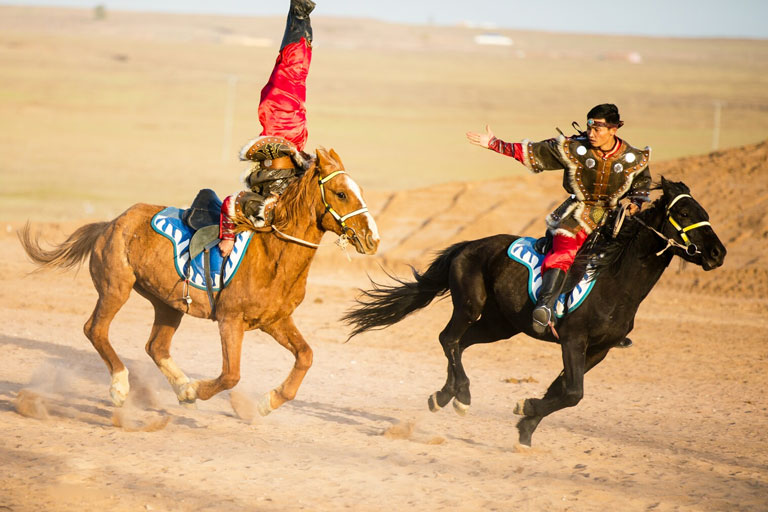 Nadaam Equestrian Shows at Genghis Khan Mausoleum
Nadaam Equestrian Shows at Genghis Khan Mausoleum
Genghis Khan Mausoleum Tourist Area is located in Yijingholuo town, Yijingholuo Banner, Ordos City, about 260 km away from the capital of Inner Mongolia Autonomous Region, Hohhot City, 160 km away from Baotou city, about 60 km away from Dongsheng District, about 28 km away from Kangbashi District in Ordos City, and only about 20 km away from the Ordos Airport. It is connected with Beijing, Xian, Ningxia by expressway, Hohhot, Baotou and other cities in Inner Mongolia by railway, which makes transportation convenient. Most travelers to the Mausoleum of Genghis Khan would get to Kangbashi District or Dongsheng District in Ordos first and then make a transfer there. Visitors may get to Ordos by flight, train, bus or car.
Check more about How to Get to Ordos & Ordos Transportation Guide >>
Dongsheng District in Ordos is about 60 km north from Genghis Khan Mausoleum Tourist Area, which takes at least 1 hour to get there by car/taxi. If you can't speak Chinese fluently, the most convenient and comfortable way to get there is by booking a private car service. For budget independent travelers, you may also take a coach/tourist bus to reach the scenic area.
By Coach/Tourist Bus: Dongsheng District in Ordos city has a direct coach to the Genghis Khan Mausoleum Tourist Area. The whole journey takes about 1.5-2 hours. Tourists may take the special tourist line to the scenic area from Dongsheng Bus Station (东胜客运中心站)or Ordos Square (鄂尔多斯广场) in Dongsheng District.
The most leisure way to get to Genghis Khan Mausoleum Tourist Area from Hohhot is by taking a bullet/ normal train to Ordos Railway Station (鄂尔多斯站), which is only 24 km away from the scenic area. Everyday, there are over 10 bullet/normal trains running between Hohhot and Ordos. The whole journey takes about 2 hours by bullet trains and 4 hours by normal trains. After getting off the train, you may transfer to a taxi or car to reach the destination (which takes less than 30 minutes).
You may also take trains to get to Ordos or Baotou city first, then transfer to a car or coach to get to Mausoleum of Genghis Khan.
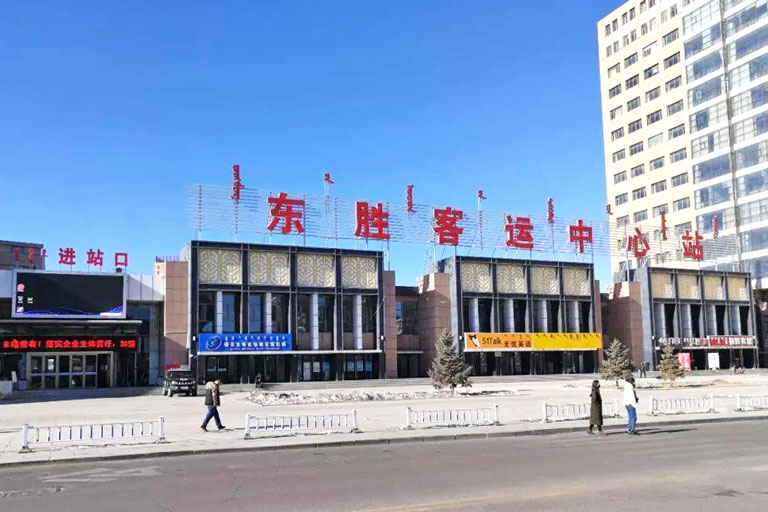 Dongsheng Bus Station
Dongsheng Bus Station
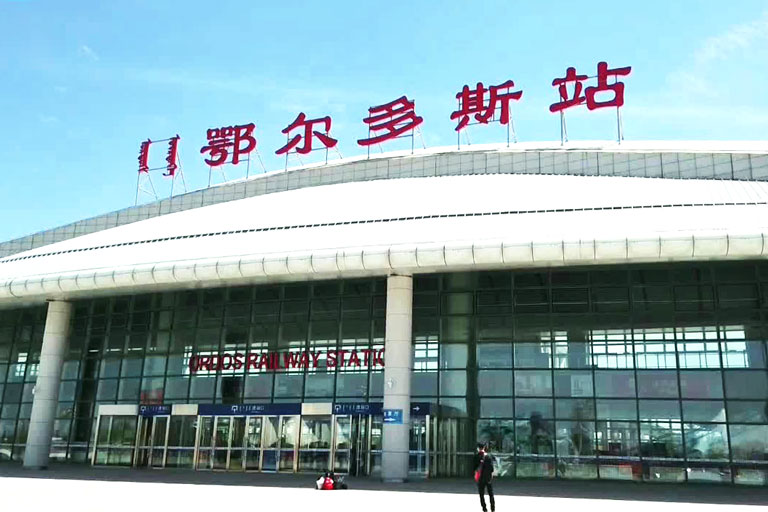 Ordos Railway Station
Ordos Railway Station
Kubuqi Desert (库布齐沙漠), located in the northern part of the Ordos Plateau in Inner Mongolia, is the seventh largest desert in China. It's not only a "Desert Disneyland" for family vacation, but also a paradise for desert hikers. Entering the hinterland of desert by jeep, camel or on foot, visitors may see the rolling golden sand dunes stretching out to the sky and listening to the resonant symphony played by the sand. Yemingsha Scenic Area (夜鸣沙), Xiangshawan Scenic Area (响沙湾) and Qixing Lake Scenic Area (七星湖) are recommended desert resorts in Kubuqi. Check more about Kubuqi Desert >>
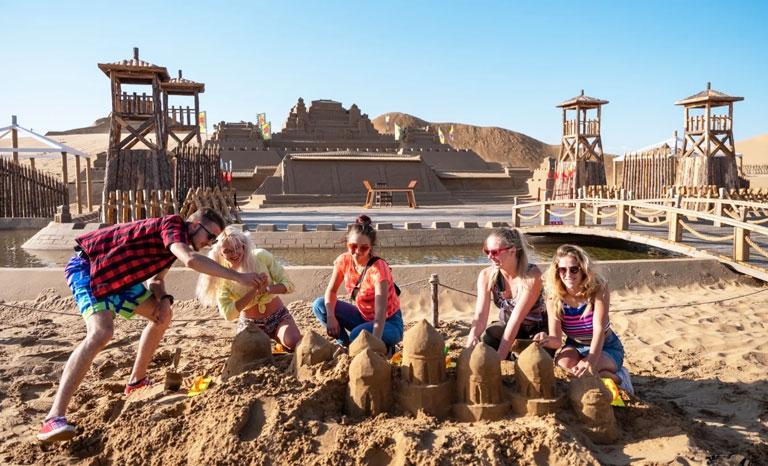 Xiangshawan Scenic Area (Kubuqi Desert)
Xiangshawan Scenic Area (Kubuqi Desert)
Kangbashi District (康巴什区), located in the hinterland of the Ordos Plateau, is the new political, cultural, financial, scientific research and education center of Ordos. It is the first 4A level scenic spot named after the urban landscape in China. Famous attractions include the Ordos Museum, Genghis Khan Square, and the Ordos Grand Theater and Wulan Mulun River Scenic Spot. Spend 0.5-1 days wandering around the rumored "ghost city" Ordos and you'll find it's not at all what you think.
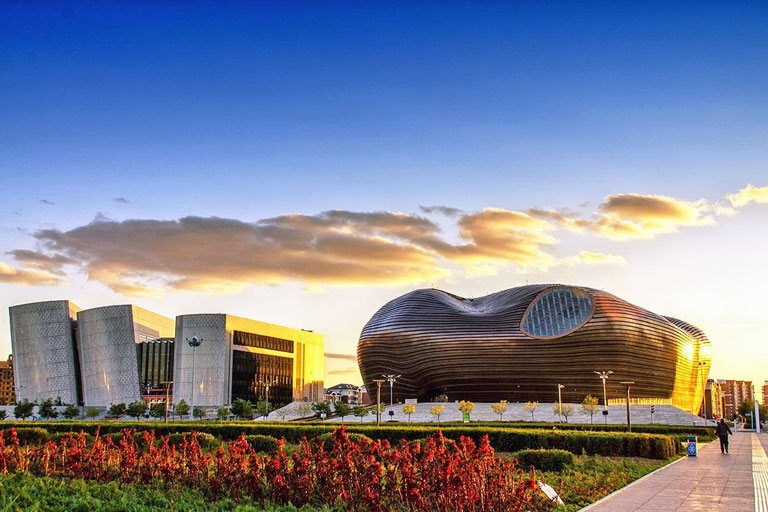 Kangbashi District (Ordos)
Kangbashi District (Ordos)
Ordos Grassland Tourism Area (鄂尔多斯草原) was built in 2004, located in the Hangjin Banner, Ordos, the "Horseback Archery Place" and the "Nomadic place", covering an area of 16,000 mu, is one of the large scale grassland recreation and tourism areas in the central and western part of Inner Mongolia. There are five highlights in Ordos grassland with strong Mongolian characteristics: the Nadaam real scene equestrian show, Zhama banquet, grassland night bonfire party, the aerial acrobatic shows and Ordos wedding performance.
Check more about Top 10 Grasslands in Inner Mongolia >>
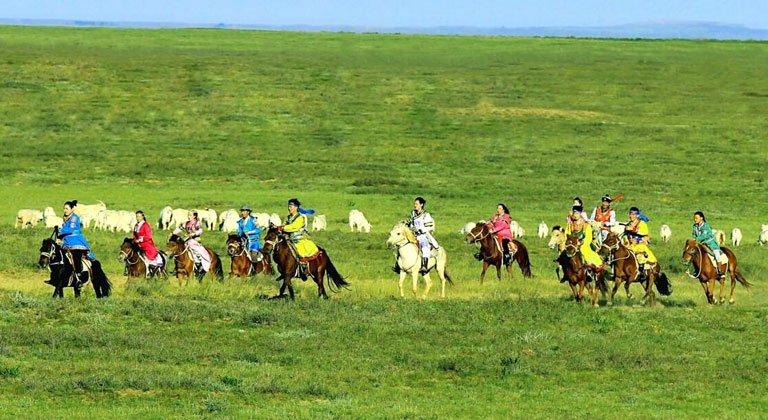 Ordos Grassland in Summer
Ordos Grassland in Summer
1. Ticket & Price: Full Price Tickets for Genghis Khan Mausoleum Tourist Area CNY 170/person from 20th April to 10th October and CNY 150/person from 11th October to 19th April. Optional (need extra cost): The Equestrian Performance (马术表演) CNY 60/person; Ordos Wedding Show (鄂尔多斯婚礼) CNY 120/person; sightseeing trains in the scenic area CNY 30/person.
2. Best Time to Visit: Genghis Khan Mausoleum Tourist Area is suitable to visit all year round, but located on the Bayin Changhuge Grassland, the surrounding environment is at its best from June to October, which is also the peak tourist season of Ordos. Check more about Ordos Weather & Best Time to Visit >>
3. Accommodation & Where to Stay: The Mausoleum of Genghis Khan is less than 30 km away from the Kangbashi New District (康巴什新区) in Ordos, which only takes about 30 minutes by car. There are all kinds of hotels in Kangbashi District for visits to choose from, from high-end hotels (like Ordos Hengxin Grand Hotel) to budge hotels (like Hanting Hotel). Therefore, visitors are recommended to stay overnight there. There are also several places around the scenic area to stay overnight, like the Bulakehaote Hotel (布拉克浩特酒店), Yijinhuoluo Ethnic Town (伊金霍洛民族风情小镇) and Bayin Changhuge Grassland Yurt Group (巴音昌呼格草原蒙古包群), etc. Check more about Ordos Hotels & Where to Stay >>
4. Festivals & Sacrificial Ceremonies: Genghis Khan's sacrifice is generally divided into weekly, monthly and seasonal sacrifices, all of which have fixed dates. Special ceremonies are held more than 60 times a year. Among them, the ceremonies of the four seasons are the most solemn, which are: Spring Chagansuluke Ceremony (the 21st day of the third month by the lunar calendar); Summer Nur Ceremony (the 5th day of the fifth month by the lunar calendar); Autumn Sirige Ceremony (the 12th day of the ninth month by the lunar calendar); Winter Dasima Ceremony (the 3rd day of the tenth month by the lunar calendar).
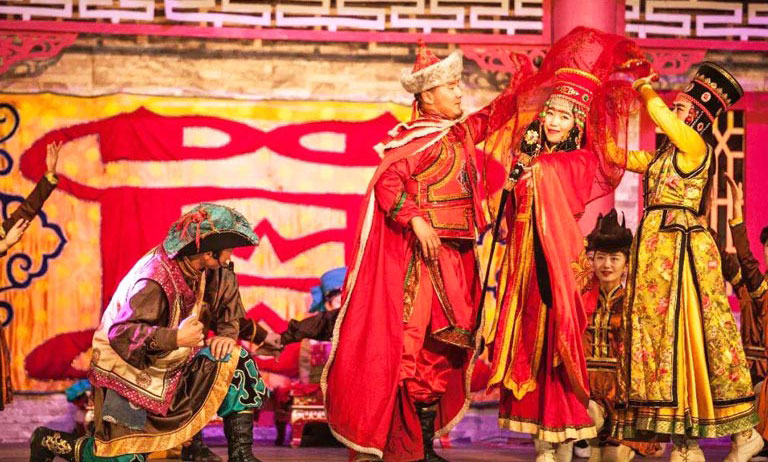 Ordos Wedding Show (鄂尔多斯婚礼)
Ordos Wedding Show (鄂尔多斯婚礼)
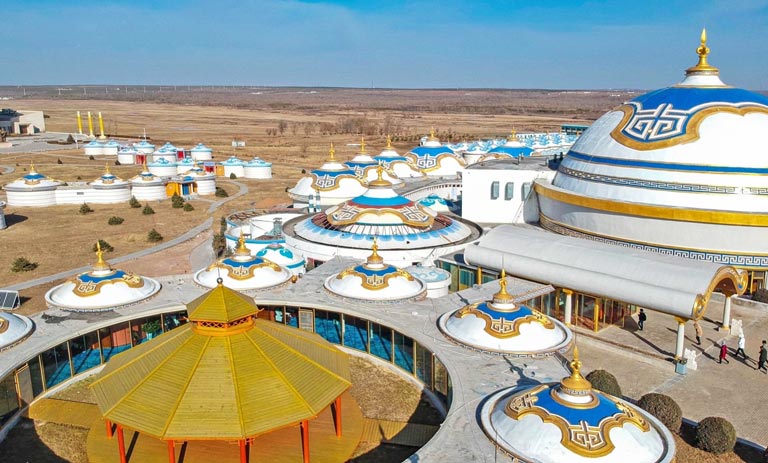 Bulakehaote Hotel near Genghis Khan Mausoleum
Bulakehaote Hotel near Genghis Khan Mausoleum
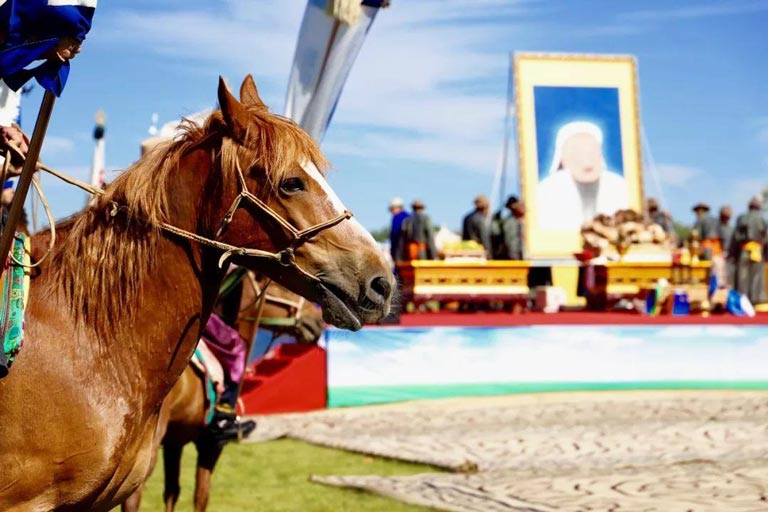 Summer Nur Sacrificial Ceremony
Summer Nur Sacrificial Ceremony
Best Time to Visit Ordos: May ~ October, especially in June, July, August and September…
How to Get There: Flights from Beijing (1.5hrs), Shanghai (3hrs), Xian (2.5hrs), Chengdu (2.5hrs), etc. and bullet train from Hohhot (1.5-2hrs), Ulanqab (2.5-3hrs), etc.
There are two biggest highlights in Ordos, one is the Kubuqi Desert, the other is the Mausoleum of Genghis Khan. It usually takes 1-2 days to explore the beauty of nature and culture in the two sites. For those who are interested in desert camping, riding and hiking can spend 1-2 more days in Kubuqi Desert. Before or after your desert tour, you can take half a day to explore the Kangbashi District in Ordos, visit Genghis Khan Sculpture Square, Mongol Chess Square and Kangbashi Gallery of Culture and Art, etc.
☛ 4 Days Inner Mongolia Grassland & Genghis Khan Culture Tour
☛ 2 Days Best Kubuqi Desert Tour to Yemingsha
For first-time visitors to Inner Mongolia, it is recommended spend 4-6 days visiting Ordos together with Baotou and Hohhot, enjoy all the highlights in the central Inner Mongolia, like the famous Tibetan Buddhist temples (Dazhao, Wudangzhao...), vast grasslands (Huitengxile Grasslands...), and wild Kubuqi Desert.
☛ 5 Days Classic Inner Mongolia Tour (Hohhot / Huitengxile Grassland / Kubuqi Desert / Ordos)
☛ 6 Days Inner Mongolia Bests Discovery Tour (Hohhot / Ulanqab / Huitengxile Grassland / Baotou / Kubuqi Desert / Ordos)
Feel not enough? You can plan 4~5 days more in Hulunbuir to meet the most beautiful grassland in China and more primitive natural splendors, 2~4 days more in Xilingol to discover the UNESCO World Cultural Heritage Site - Site of Xanadu, and more authentic nature, or 4-5 days in Chifeng to soak in the Ulan Butong Grassland and other wonders in Hexigten Global Geopark. Do you have your own preferences about Ordos and Inner Mongolia? Please feel free to tell us your likes and let our experienced travel consultant customize a tour for you!
☛ 5 Days Best Hulunbuir Tour with Grassland Exploration
☛ 5 Days Classic Hexigten Scenic Tour with Wulan Butong Grassland
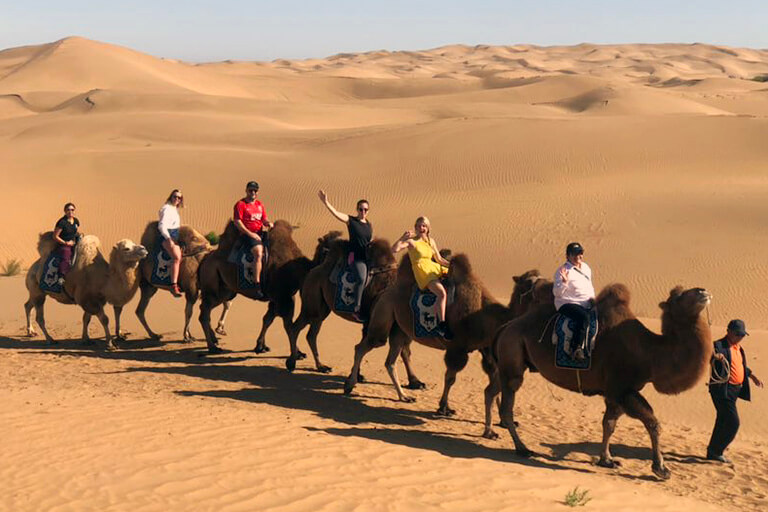 Camels Riding at Kubuqi Desert
Camels Riding at Kubuqi Desert
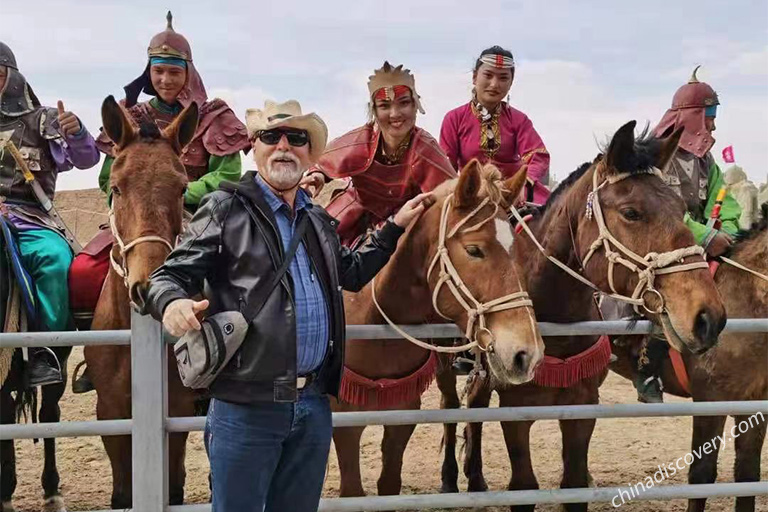 Horse Riding on Xilamuren Grassland
Horse Riding on Xilamuren Grassland
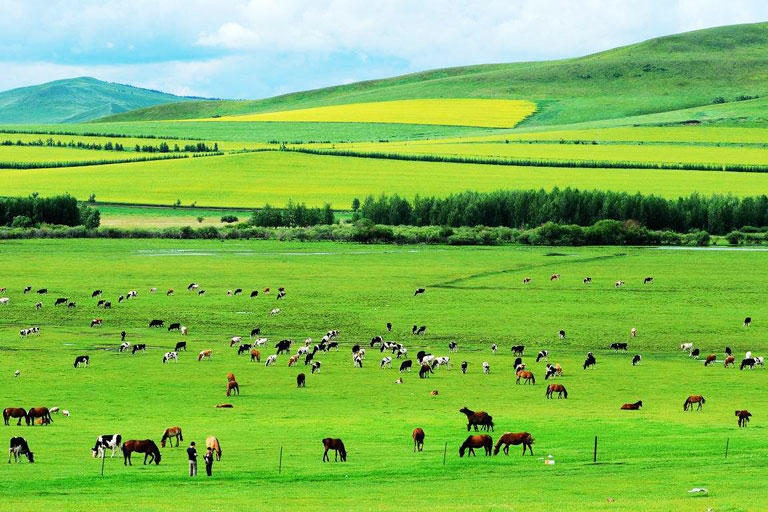 Hulunbuir Grassland
Hulunbuir Grassland
As attractions in Ordos are separated, travelling with a professional travel agency is usually the best way to visit there. We China Discovery know Ordos and Inner Mongolia a lot and we are experienced in organizing tours to this region. If you need any help, please feel free to contact us! Private cars, one-to-one guide and travel consultant... Everything is only for you and your group or family! All tours are customizable based on your interest, budget, plan and every special need!
Top 3 Mausoleum of Genghis Khan tours chosen by most customers to explore Mausoleum of Genghis Khan in the best way. Check the detailed itinerary, or tailor your own trip now with us.
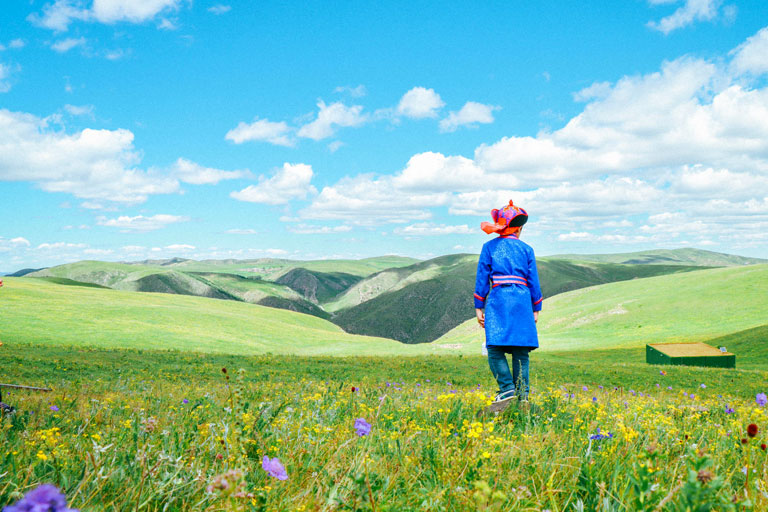
Hohhot / Huitengxile Grassland / Yemingsha of Kubuqi Desert / Hohhot
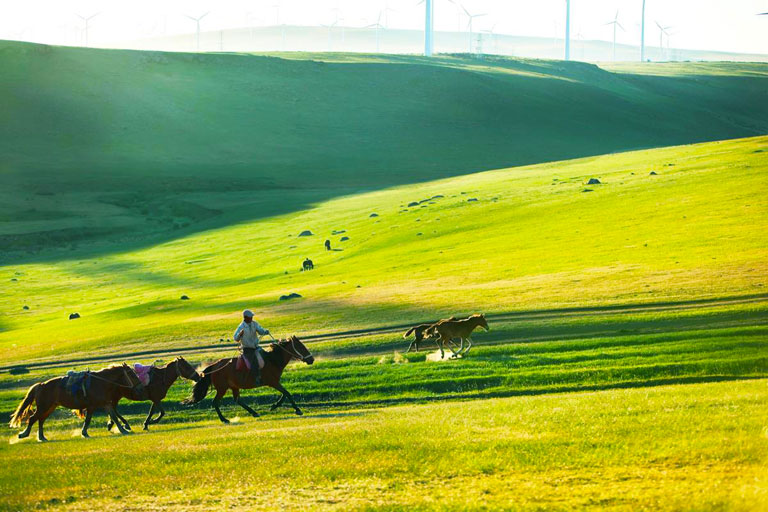
Hohhot / Ulanqab / Huitengxile Grassland / Hohhot / Baotou / Yemingsha of Kubuqi Desert / Ordos
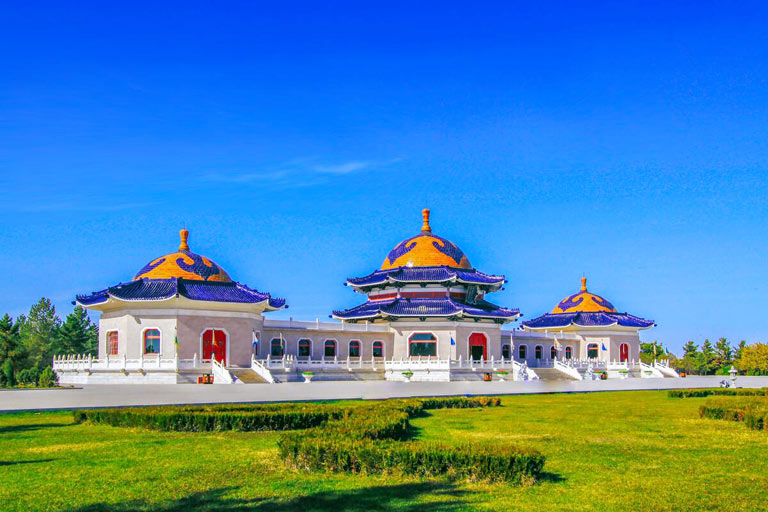
Hohhot / Huitengxile Grassland / Ordos
Start planning your tailor-made holiday to China by contacting one of our specialists. Once inquired, you’ll get a response within 0.5~23.5 hours.
Customize a Trip